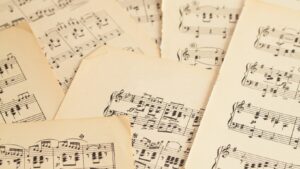Ever wondered why certain moments in music give you goosebumps, or why a piece of music feels complete at the end? The secret lies in the power of cadences. Cadences, the punctuation marks of music, are pivotal in shaping our emotional response to a melody. They’re the unsung heroes that provide closure, create tension, or leave us hanging in anticipation.
Delving into the world of cadences isn’t just for seasoned musicians—it’s a fascinating journey for anyone with a love for music. Understanding cadences can deepen your appreciation of your favorite tunes and even enhance your own musical creations. So, let’s embark on this melodious journey to explore the magic of cadences in music theory.
Cadences Music Theory
 Delving deeper into cadences unravels the captivating intricacies of music theory. This section, focusing specifically on understanding cadences within music theory, will delve into the definition of cadences and the distinct types that exist.
Delving deeper into cadences unravels the captivating intricacies of music theory. This section, focusing specifically on understanding cadences within music theory, will delve into the definition of cadences and the distinct types that exist.
Cadences, often termed the ‘punctuation marks of music’, serve a critical function in shaping the rhythmic and melodic pace of a musical piece. In music theory, a ‘cadence’ means the sequence of chords that concludes a phrase, section, or piece of music. Much like the period at the end of a sentence, cadences offer a sense of resolution, signifying the end of a musical idea. However, cadences don’t only provide closure.
Primarily, five types of cadences are recognized in Western music. Each one varies in regards to the impact it leaves on the listener.
- Perfect Authentic Cadence: This kind, often used at the end of a musical piece, includes the V (dominant) chord moving to the I (tonic) chord. It provides the most solid and complete closure.
- Imperfect Authentic Cadence: Here, the motion from the V chord to I chord is present, but it’s not in root position or in a different context, hence offering less finality than the perfect authentic cadence.
- Plagal Cadence: Dubbed the ‘Amen cadence’, it features a IV to I progression, originating from the customary “Amen” sung at the end of hymns.
Each of these cadences has unique characteristics that contribute to the nuance and depth of a musical piece. Understanding them heightens one’s ability to appreciate and create music.
The Role of Cadences in Musical Composition
 Immersing deeper into music theory’s realm, cadences give a unique character to the melodies. They’re the musical threads that knit emotions into compositions. This section uncovers the operational and emotional facets of cadences in music composition.
Immersing deeper into music theory’s realm, cadences give a unique character to the melodies. They’re the musical threads that knit emotions into compositions. This section uncovers the operational and emotional facets of cadences in music composition.
Cadences play a powerful, almost indispensable role in offering closure in music. Think of them as musical full stops. They demarcate phrases and sections, granting a sense of completion to a melodic sentence before a new phrase comes into play. For instance, listening to Mozart’s symphonies, you’ll perceive numerous cadences at work, rendering satisfying closure at the end of each musical statement.
Consider the Perfect Authentic Cadence, one of five cadences in Western music that creates a solid closure. This particular cadence often signals the end of a piece or section, bringing about a sensation of resolution by registering a shift from the dominant chord to the tonic chord.
Examining Cadences in Different Genres
 Music genres differ widely, but the use and significance of cadences remain ubiquitous. In this section, let’s dive into the application of cadences in Classical and Modern Popular music genres.
Music genres differ widely, but the use and significance of cadences remain ubiquitous. In this section, let’s dive into the application of cadences in Classical and Modern Popular music genres.
Classical music, rich in rhythmic complexity, extensively uses cadences for distinctive closing phrases. For instance, the Perfect Authentic Cadence, transitioning from the dominant chord to the tonic chord, retains its importance in Classical style. It offers decisive closure in symphonies, concertos, and sonatas, marking the end of movements or entire pieces. Mozart’s Symphony No.40 exemplifies it, manipulated expertly to deliver the finality in its movements.
Additionally, the Deceptive Cadence enhances musical narratives with an unexpected twist. It resolves to a different chord than the anticipated tonic, disrupting emotional predictability. One can spot its use in Haydn’s “Surprise” Symphony, which leverages this cadence for dramatic and surprising effects. These include promoting a sense of longing, indulging in a sense of playfulness, and introducing surprises.

